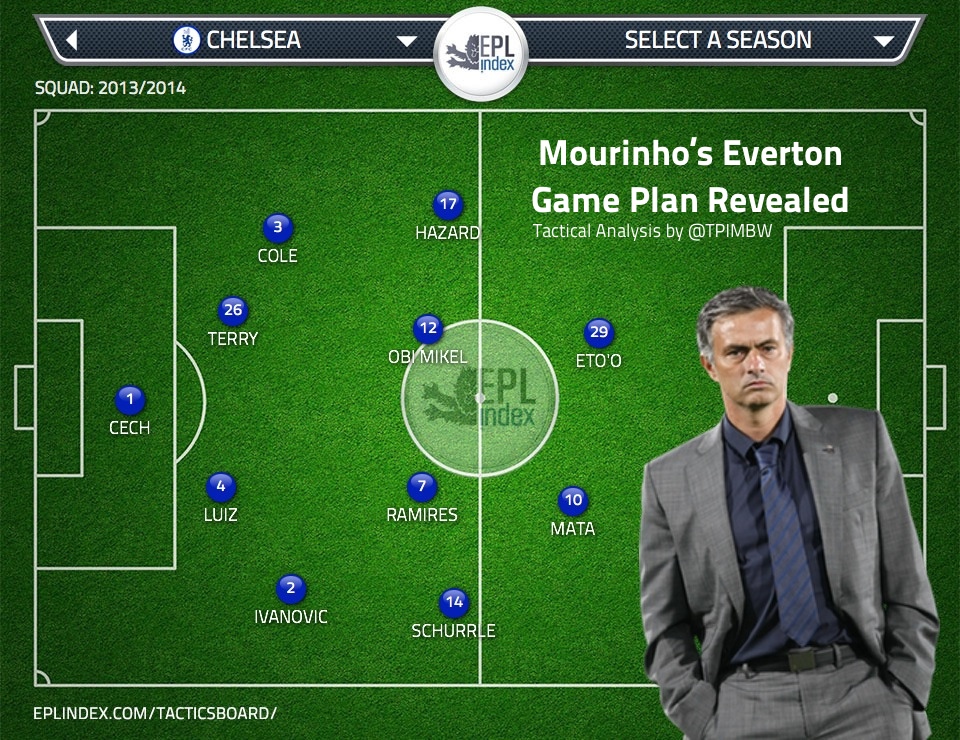Sometimes in football it is individual players or those unique unplanned moments, rather than the collective strategy that a team has been working on all week in preparation for a football match, that wins football matches.
Chelsea, statistically speaking, (bar the scoreline statistic) should have walked out of Goodison Park victorious. Chelsea created more clear cut chances than Everton, they had twice (16 to 8) as many shots from within the 18-yard box and accumulated a total of 31 penalty area entries over Everton’s 11, as Martinez’s side conceded the possession statistic for the first time this season. This view is shared by Mourinho as he declared that he felt Everton didn’t create much, but instead benefitted from the mistake of an individual.
Roberto Martinez’s set up for Everton against Chelsea was consistent to how they have set up in all of their opening fixtures in the 2013/14 Premier League season. The analysis of Everton’s proactive set up both in defence and attack can be found in an article written after the opening fixture of the season against Norwich found here. To understand why Jose Mourinho decided to set up defensively the way he did against Everton, requires you to know that Everton’s formational changes from defending to attacking, consist of Everton changing from a 4-3-2-1 (or 4-5-1 in the deepest areas) to a 2-4-1-3 formation during their attacking transition. Likewise, this means that Everton undergo an important defensive transition when losing the ball, in order to regain their defensive shape – otherwise, Everton would be left vulnerable at the back given the numbers they commit forward, particularly when both Baines and Coleman have pushed right into the final third, positioned as wingers, rather than traditional wing-backs.
Knowing this, Mourinho saw an opportunity to use one of Everton’s strengths (the wing-backs) and turn it into their biggest weakness. To understand how Mourinho planned to achieve his game plan, we must first understand why Chelsea’s defensive line was set so deep and how it could benefit Chelsea’s subsequent counter attack.
CHELSEA’S OUT OF POSSESSION FORMATION WHEN EVERTON POSSESSED THE BALL IN THEIR OWN HALF
When Everton had possession of the ball in their own half, Chelsea’s defensive line would fall back towards their own penalty box, rather than look to hold a high line. This strategy invites Everton to bring the ball forward and at the same time, reduces the opportunity for the referee to blow his whistle to give offside.
When an offside is given, this allows the attacking side (Everton) the time to return back to their defensive shape without the counter-attacking defensive team (Chelsea) being able to test them – therefore, by sitting deep, you not only invite the Everton players forward but you invite the opportunity for your attacking transition to beat their defensive transition (counter-attacking), with the simple theory that if you can attack quicker than they can get back into their defensive shape, you increase your opportunities of creating a goal-scoring chance! With the pace that Chelsea have going forward, it is understandable as to why you may have the confidence that you could win this battle.
This strategy fundamentally looks to highlight the possible weakness in a team that changes formation as much as Everton do (specifically focusing on the positioning of their full-backs). Furthermore, it was noticeable that both Mata and Eto’o would look to show Everton down the flanks as they curved their runs to ALWAYS show the Everton players down the line when in possession of the ball – again encouraging the Everton full-backs to get forward.
As Chelsea dropped back further still, they would do so knowing that the Everton wing-backs have committed themselves to attack. For these reasons, you can comprehend the rationale behind the formation Chelsea would fall back into when Everton had the ball in the Chelsea half.
DEFENSIVE BLOCK WHEN EVERTON HAD THE BALL IN THE CHELSEA HALF
Leaving Hazard and Schurrle further forward, Chelsea now had three attacking options to counter attack through. Eto’o would look to get in between the two central defenders, and both wingers would look to attack the spaces left in behind Everton’s wing-backs. On the other hand, if none of these three options were available to counter attack through after winning the ball, Chelsea would then look to build and probe with possession from the back – it was also observable (particularly in the first half) that the Chelsea defenders would look to play long diagonal balls across the field when trying to catch the Everton wing-backs out of position.
Chelsea’s attacking transition therefore began with Chelsea attacking the spaces on the flank, and then relying on the midfield (and supporting players) to arrive late in key central areas. When we look at Chelsea’s attacking shape however, we can begin to piece together the two different approaches to attacking. If the counter-attack wasn’t on as described above in terms of one of the front three finding the positions to counter-attack, then there was a shape that encouraged Chelsea to build and probe in key central areas
CHELSEA’S ATTACKING SHAPE AND “CONTROLLED ATTACK APPROACH”
The “pinched-in” attacking midfield trio of Chelsea were far from static, and this was particularly noticeable when analysing the movement between Schurrle and Mata, as there were times when all three would have taken up each others positions behind Eto’o. During the “controlled-attack” approach, the option of width often relied on the attacking movement of Ivanovic and Cole going forward.
CONCLUSION
Mourinho’s game plan and model against Everton was one that is typical of the Portuguese tactician: both rational and intelligent in terms of how to turn the opposition’s strengths into a weakness. The considered and calculated risk of inviting Everton’s wing-backs to attack, unfortunately didn’t have any direct impact on Chelsea’s ability to put the ball in the back of the net but there were times where Mourinho’s plan nearly came into fruition.
As the cameras gazed across at The Special One, there were signs of Mourinho’s body language saying “what more can I do for you” to the Chelsea players as they failed to convert the opportunities created through Mourinho’s game plan – a game plan that created the conditions conducive to counter-attacking and also giving the second option of a “controlled attack” if the primary option of counter attacking wasn’t available.
SUMMARY OF THE EVERTON STRATEGY FROM MOURINHO
- Deep defensive line to encourage play to continue and test the counter-attack against an unorganised defence.
- Front two forcing play down the flanks and encouraging the wing-backs to get forward
- Use the front trio as a counter-attacking outlet
- Central players to make well-timed runs in behind the Everton midfield
- Look to exploit the Everton high line through well-timed runs – possibly through patterned play, learnt in training throughout the week (Ramires came close)
- If the counter-attack isn’t an option, look to build and probe and maintain fluid movement with the attacking trio behind the striker
- Formation changes to encourage the game plan: 2-4-3-1 in controlled attack, 4-4-2 in first phase of defending, 4-3-2-1 in the middle phase of defending and lastly, 4-5-1 in the final phase of defending.
REFERENCES:
1. Everton’s style and formation under Roberto Martinez: Click here to read an article written after the opening fixture of the season for Everton against Norwich




